United States Family Medicine research collaborations associated with higher citation and funding rates
Vivian Jiang 1 2 6 , Stephen Petterson 3 , Elizabeth Wilkinson 3 , Alison Shmerling 1 , Yalda Jabbarpour 3 , Andrew Bazemore 4 , Winston Liaw 51 Department of Family Medicine, University of Colorado, Denver, CO, USA.
2 Family Medicine for America’s Health, Fairfax, VA, USA.
3 Robert Graham Center for Policy Studies in Family Medicine and Primary Care, Washington, D.C., USA.
4 American Board of Family Medicine, Washington, D.C., USA.
5 Department of Health Systems and Population Health Sciences, University of Houston College of Medicine, Houston, TX, USA.
6 Corresponding author. Email: Vivian.Jiang@cuanschutz.edu
Journal of Primary Health Care 13(3) 238-248 https://doi.org/10.1071/HC20136
Published: 13 August 2021
Journal Compilation © Royal New Zealand College of General Practitioners 2021 This is an open access article licensed under a Creative Commons Attribution-NonCommercial-NoDerivatives 4.0 International License
Abstract
INTRODUCTION: Among academic medical disciplines, Family Medicine (FM) research is notable for its breadth of health-care content areas, making it particularly susceptible to interdisciplinary collaboration.
AIM: This study characterises the degree and typology of such collaborations, and determines whether collaboration patterns are associated with citation frequency and funding.
METHODS: This cross-sectional study describes collaboration patterns for publications from 2015 indexed in Web of Science and authored by faculty from United States (US) departments of family medicine (DFMs). We determined mean number of total and FM authors per publication, and percentage of publications with FM first or last authors. Publications were categorised by inclusion of non-FM faculty author(s) and number of DFMs represented.
RESULTS: Overall, 919 FM faculty from 109 DFMs authored a total of 1872 unique publications in 2015. There was an average of 6.8 authors per publication with 1.4 authors being FM faculty. FM faculty were first author on 26.2% and last author on 29.2% of publications. Of all publications, 0.9% were single FM Author; 1.0% were same DFM; 0.3% were multiple DFMs; 72.4% were single FM Author+non-FM; 19.3% were same DFM+non-FM; 6.0% were multiple DFMs+non-FM. FM publications with non-FM faculty authors showed higher citation rates, higher rates of funding, and lower rates of having no funding source.
DISCUSSION: Most FM publications involved non-FM faculty authors. Collaborations involving non-FM authors were correlated with higher impact publications and projects that were more likely to have been funded.
KEYwords: Collaborations; collaborative research; team science; family medicine research; academic medicine.
Introduction
Over the past century, science has steadily shifted from solo work to teamwork. Wuchty et al.1 note that in reviewing publications from all scientific fields from the 1950s to the early 2000s, the number of authors per paper nearly doubled from 1.9 to 3.5. Furthermore, teams tended to produce research of higher impact with higher citation rates.1 The rapid expansion of medical knowledge and increasing complexity of scientific research has made collaboration and teamwork highly encouraged and sometimes necessary across medical specialties and allied fields.1–3 Unique in its breadth of clinical practices and research topics, Family Medicine (FM) provides an ideal venue for studying the role of collaboration in academic medicine.4,5
Internationally, primary care and FM research has been growing steadily.6,7 FM researchers publish in non-clinical fields and experts in other fields contribute to FM journals.8 A SCOPUS search for 2012 alone showed that the 250 most-cited FM articles spanned 73 different journals on topics ranging from epidemiology to speciality care, health policy to information technology, medical education to workforce needs.9 In addition to its topical diversity, FM is also unlike most medical research in that it extends beyond academic walls into community clinics through practice-based research networks.10,11
Previous studies of FM scholarly output around the world have focused on quantity and impact of research articles over time.6,7,10,12 No existing literature addresses the multidisciplinary nature of FM research, and little is known about research collaboration with other specialties and whether these collaborations should be encouraged. This study uses data on US FM publications to describe the number of authors, author order, author composition, citation rate, and funding among publications, with at least one FM scholar. We additionally aim to assess whether team composition involving collaboration across departments, disciplines, and specialties is associated with citation rates and research funding.
Methods
Data sources
We identified DFMs using a 2015 database from the US Association of Departments of Family Medicine. This source included 134 allopathic and osteopathic DFMs. After identifying the DFMs, we used the websites for each department to identify faculty names and their degrees and titles.
We used the Web of Science database to collect articles published between 1 January 2015 and 31 December 2015 authored by the DFM faculty. Web of Science provides unique article identification, article title, funding source, publication category, and author affiliations and locations (Figure 1).
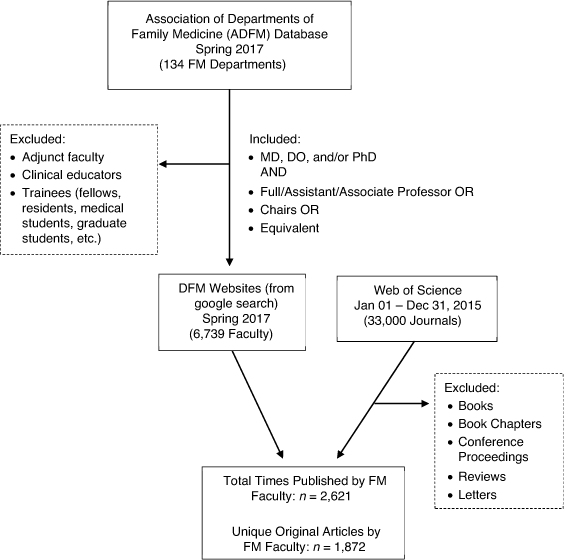
|
Variables
Academic institutions and faculty names, titles, and degrees were found using a Google search to access DFM web pages in Spring 2017. Faculty included had the titles of Chair, Professor, Associate Professor, Assistant Professor, Professor and equivalent clinical positions in any division within a DFM. Instructors listed as adjunct faculty, clinician educators, and trainees (fellows, residents, medical students, graduate students, etc.) were excluded.
Of the 43 possible Web of Science publication categories, we included only the original articles category. Excluded publications included books, book chapters, conference proceedings, reviews, and letters. Only original articles were included in the study, defined in Web of Science as research on original work (Figure 1).
We matched author name and institutional affiliation from publications with the faculty name and institutions for each author from the DFM websites. Additional Web of Science factors used to match faculty were author location (city, state, and country) and department. For unmatched cases, we hand-checked the article title and author name and excluded publications listing an author affiliation that did not directly match the author’s institutional faculty appointment.
We categorised DFMs into size quartiles by number of faculty. In the US and for the purposes of this study, people with Doctor of Medicine (MD) and Doctor of Osteopathy (DO) degrees are considered equivalent in abilities to conduct medical research. We assessed author-level characteristics of degree type (MD or DO only, combined as ‘MD’, Doctor of Philosophy (PhD) only, MD and PhD, and Other) and faculty position (Chairs, Professors, Associate Professors, Assistant Professors, Professors and equivalent Clinical positions). By article, we assessed funding as reported to Web of Science, one of the most accurate and complete databases indexing funding acknowledgments.13 We grouped funding source into four categories: federal, university, other, or none. The ‘other funding’ category included funds that could not be attributed to an author’s university or to US federal agencies; for instance, foundation, state, international, or private funding were classified as ‘other funding’. We assessed citations per publication as of Spring 2017.
We classified authors into two overarching categories: FM or non-FM authors. FM authors were academic DFM individuals who met the faculty position criteria. Non-FM authors were listed on the Web of Science article author list who did not match to the DFM faculty list, including, but not limited to, individuals in different departments in the same or different academic institutions, individuals not in academia such as those in government or corporate agencies, and individuals in FM who did not meet faculty criteria, including adjunct faculty, clinician educators, or trainees. First and last authors were identified by Web of Science author list order. Last author was excluded for publications with less than three authors.
We developed a schematic of FM authors’ collaborative relationships (Figure 2). The first category included articles with FM-only authorship and had three subgroups: a single FM author, multiple authors in a single DFM, or multiple authors in multiple DFMs. The second category included articles with FM and non-FM authorship. These articles had at least one non-FM author and either a single FM author, multiple authors in a single DFM, or multiple authors in multiple DFMs.
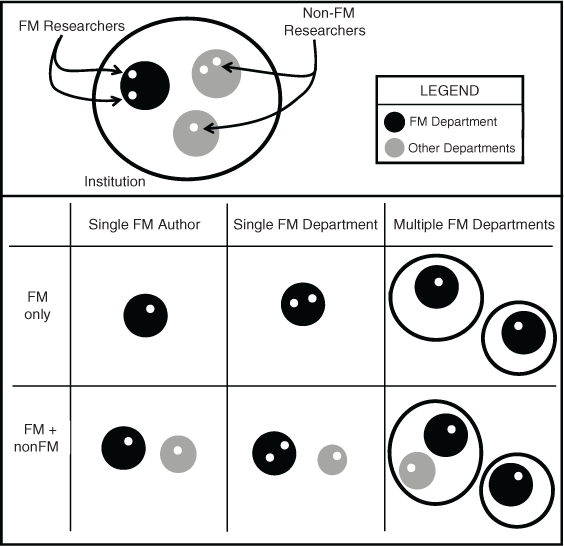
|
Analysis
We used univariate and bivariate analyses to assess first and last authorship, number of authors, citations, and funding by FM authors’ DFM size, faculty position, and faculty degree. We assessed citations and funding by the publication’s collaborative relationship type. We assessed FM-author-level characteristics including DFM size, faculty title, and faculty degree, with 2015 FM original research publications as the dependent variable. In FM-author-level analyses, publications are counted more than once to account for multiple FM faculty members contributing to the same publication. We assessed the publication-level collaborative relationship type, with the same dependent variable and each publication was counted once. We used chi-square tests to determine statistical associations between any funding and collaboration type, Fisher’s exact test to determine associations between funding type and collaboration type, and analysis of variance tests to determine statistical associations between average citations and collaboration type. We used Stata Version 14.2 for the analysis (StataCorp).
Results
In 2015, 919 FM faculty from 109 DFMs authored 1892 original research articles. This equates to FM faculty publishing a total of 2621 times, with 1872 unique original research articles because multiple FM authors can contribute to the same publications. There was an average of 6.8 total authors per publication: 1.4 were FM faculty members and 1.3 were FM faculty authors from the same university. The mean number of total authors per publication was greatest for publications from the largest departments (131–289 faculty) and publications authored by DFM chairs, but did not differ greatly based on faculty degree(s) (Table 1).
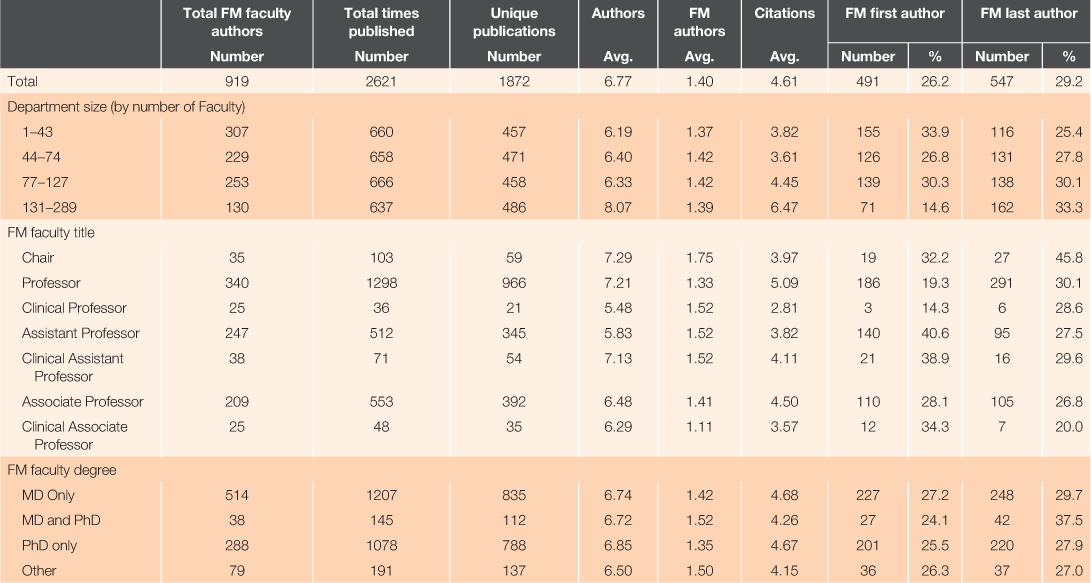
|
FM faculty were first author on 26.2% (491/1872) and last author on 29.2% (547/1872) of all publications with any FM author in 2015. There were greater rates of FM first authors for publications with FM faculty from the smallest departments (155/457, 33.9%) and with Assistant Professor titles (clinical 21/54, 38.9%; non-clinical 140/345, 40.6%). There were greater rates of FM last authors for publications with FM faculty from the largest DFMs (162/486, 33.3%), chairs (27/59, 45.8%), and faculty with dual MD and PhD degrees (42/112, 37.5%).
Publications in 2015 by FM faculty had an average citation rate of 4.6 per publication by 2017. The overall funding rate for FM faculty original research publications in 2015 (n = 1872) was 76.2% (1427/1872) (Table 2). This included 58.2% (1089/1872) of publications reporting federal funding, 12.1% (227/1872) reporting university funding, 13.3% (249/1872) reporting funding from another source, and 23.8% (445/1872) reporting no funding source. Both average citation rate and funding rates differed based on department size. Compared to smaller departments, publications with faculty from the largest departments had higher average citation rates (6.5 vs. 3.8), higher rates of any funding (429/486, 88.3% vs. 297/457, 65.0%), and higher rates of federal funding (363/486, 74.7% vs. 214/457, 46.8%) (Tables 1 and 2).
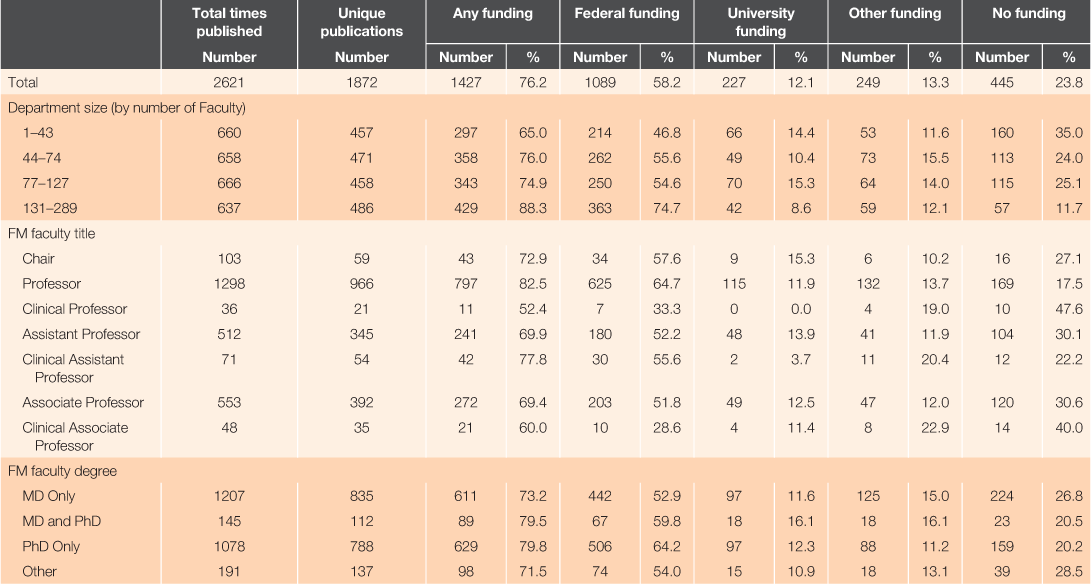
|
Of the 1872 unique publications with FM faculty authors in 2015, FM faculty authors collaborated with non-FM faculty authors on 1831 publications (97.8%) (Table 3). The most frequently occurring collaboration pattern was one FM author publishing with non-FM authors (1356/1872, 72.4%). The least frequently occurring type of collaboration was authorship by multiple FM faculty from different DFMs (6/1872, 0.3%).
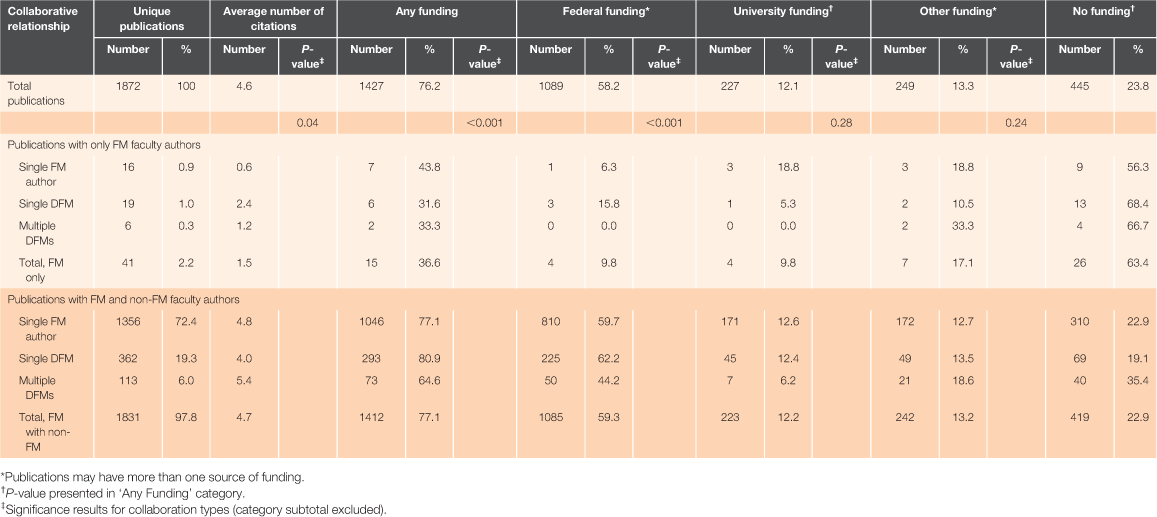
|
Average citation rates, overall funding rates, and federal funding rates all differed by collaboration type (Table 3). Publications with non-FM faculty authors were cited more frequently than publications with FM authors only (P < 0.001). This was true overall (4.7 vs. 1.5), as well as for each configuration of FM authors: single FM author (4.8 vs. 0.6), multiple FM authors from the same DFM (4.0 vs. 2.4), and multiple FM authors from multiple DFMs (5.4 vs. 1.2). Comparing publications by FM authors only, authorship by FM faculty from multiple DFMs had higher citation rates than authorship by a single FM author (1.2 vs. 0.6). This relationship held for publications by FM authors with non-FM authors as well (5.4 vs. 4.8).
Regarding funding rates, publications with non-FM authors had higher percentages of any funding (P < 0.001) and federal funding (P < 0.001) compared to publications by FM authors only. This was true overall (77.1% vs. 36.6% any; 59.3% vs. 9.8% federal), as well as for each configuration of FM authors: single FM author (77.1% vs. 43.8% any; 59.7% vs 6.3% federal), multiple FM authors from the same DFM (80.9% vs. 31.6% any; 62.2% vs. 15.8% federal), and multiple FM authors from multiple DFMs (64.6% vs. 36.6% any; 44.2% vs. 0.0% federal).
Discussion
The growth of teams in all fields of science has been well documented over the past century, leading to higher impact research products. This study finds that the same is true in FM research in the US. Internationally, the FM and primary care research fields continue to expand. Previous bibliometric studies have examined the development, volume and citation rates of primary care research in the US, Canada, the UK, Europe, and Australia.6,10,12 Countries with the greatest quantity and quality of primary care publications share several characteristics, including an emphasis on primary care in the health-care system and universities, strong academic institutions, and structuring of primary care research teams.7 This study delves further into how collaborations by academic primary care researchers within the US may enhance citation and funding rates. Future work could include assessing the impact of international collaborations.
US data show that FM faculty are highly collaborative, both leading and contributing to original publications with experts from other fields. In 2015, FM faculty worked with researchers outside FM on 97.8% of papers, were first authors on 26.2% of papers, and were last author on 29.2% of papers. Publication teams included a mean of 6.8 authors per publication, just over one-fifth (1.4 authors, 20.9%) of whom were FM faculty. By detailing the composition of these teams and evaluating the significance of different compositions, our study advances the current understanding of team science beyond just number of authors, but also the presence of multiple disciplines per team.
Papers written by FM faculty in collaboration with non-FM researchers exhibited significantly higher citation rates, rates of any funding, and rates of federal funding. Higher citation and funding rates also correlated with larger DFMs. This may be because larger DFMs provide greater opportunities for collaborations both within the FM department as well as with other departments, as larger DFMs presumably live in larger universities with a greater diversity of other disciplines present.
Regarding citation rates, authorship by multiple authors correlated with significantly more citations than authorship by a single author among papers with only FM faculty authors. Additionally, although multiple authors produced more frequently cited papers than solo authors, multiple authors from multiple disciplines produced even more frequently cited papers than multiple authors who were all FM faculty. The highest citation rate (5.4) was for papers where teams consisted of FM authors from multiple DFMs and non-FM researchers. This is nearly 10-fold higher than the collaboration type associated with the lowest average citation rate of 0.6 for papers authored by a solo FM author. Using citation rate as a proxy for impact, these findings suggest that research teams with more diverse expertise produce more impactful publications.
The value of collaborative, multidisciplinary research in FM is further seen in its correlation with funding. Papers authored by both FM faculty and non-FM researchers were funded at more than twice the rate of papers authored by FM faculty alone (77.1% vs. 36.6%). This difference is greater when comparing federal funding rates where 59.3% of papers with non-FM authors claimed federal funding compared to 9.8% of papers authored by FM faculty only. There are several possible explanations for this. Growing recognition of the importance of cross-disciplinary research collaborations in the US has led to funding sources such as Clinical and Translational Science Awards aimed specifically at interdisciplinary projects. Some postulate that the increasing cost of big science has driven researchers to work in teams as a means of sharing resources. It is also possible that the interdisciplinary teams were formed before funding availability and that collaborative grant applications were more likely to be funded than grant applications submitted by teams of FM faculty only.
These results have important implications for the current and future state of research in FM, other medical specialties, and allied health fields. The rapid expansion of medical knowledge in all specialties makes collaboration between primary care clinicians and members of other health-care disciplines inevitable. The research questions that arise from FM clinicians collaborating with speciality clinicians to care for increasingly complex patients naturally calls upon a similarly interdisciplinary team of researchers. By collaborating with other disciplines, FM faculty are weaving primary care principles into other disciplines and leveraging ideas from other disciplines to improve both the quality of research and the delivery of primary care. This exchange of ideas at the intersection of disciplines is theorized to be an important driver of ground-breaking new ideas and innovation.14
There are several limitations of this study. First, we used data from 2015. A future study using updated data would be helpful in determining how findings may change over time, though one might hypothesise that the relationship between research collaboration, publication impact, and likelihood of funding are unlikely to change significantly from year to year. Despite cuts in research funding by the recent US federal government, the proportion of funding specifically dedicated to primary care research does not vary significantly. Increasing impact and funding of research by FM faculty would require a significant shift in proportion of research funding dedicated to primary care. A second limitation remains that minimal details exist on the identity of the non-FM faculty collaborators. Medical graduate and undergraduate students, residents, and fellows were not considered faculty and were therefore categorized as non-FM researchers. Statisticians who are frequently an integral part of FM research teams were also not consistently listed as FM faculty across different universities. A substantial proportion of non-FM researchers therefore could have simply been trainees, team statisticians, or statistics graduate students rather than researchers from other fields. Additionally, many FM faculty work closely with other FM researchers from primary care research organisations, think tanks, and practice-based research networks. Collaborators in these settings were classified as non-FM faculty despite their being FM researchers. FM faculty who listed non-academic affiliations on their publications would also have been classified as non-FM researchers for those publications.
Accuracy of faculty lists on websites depended on how frequently those websites are updated and due to the lack of a unique identifier that spans faculty rosters and Web of Science publications, a subset of authors were matched by hand, leading to inherent human errors in these methods. Elucidating the nature of the non-FM faculty researchers in this study could help to detail the significance of their correlation with publication impact and funding rates.
Finally, this study used only Web of Science to identify funding sources. One study comparing accuracy and completeness of funding acknowledgments found that Web of Science, PubMed, and the National Institutes of Health (NIH), RePORTER, are all comparable, but no single source indexed the funding source for all publications produced from NIH supported grants between 2008 and 2018. In this study, Web of Science returned the highest percentage of funding acknowledgments for publications not found in the other two databases, and returned a total of 80% of publications’ funding sources. PubMed returned the highest percentage of publications with funding acknowledgments (93%).13 Future studies may benefit from cross-referencing both Web of Science and PubMed to create a more complete list of publications that listed a funding source.
In conclusion, the growth of teams in science is exemplified in FM research in the US. US FM faculty worked with non-FM researchers on 97.8% of papers. Collaborative papers involving non-FM faculty authors had significantly higher citation rates and were significantly more likely to be funded. These findings reflect the breadth of FM research, provide insight into how FM research is conducted in the US, and demonstrate the value of collaborative research teams. Efforts to facilitate research partnerships between academic FM researchers and other academic medical specialties, allied health professions, and researchers outside academia should be encouraged both through academic incentives and through development of novel government and private funding sources. Further studies are needed to better understand the application of these findings to FM research in other countries.
Competing interests
The authors report no conflicts of interest, financial or other.
Prior presentations
Jiang V, Petterson S, Liaw W, Shmerling A, Bazemore A. Research Collaboration in Academic Family Medicine. North American Primary Care Research Group Annual Conference, Chicago, IL (Nov. 2018) (Oral Presentation).
Funding
This work was funded by grants from Family Medicine for America’s Health and the American Board of Family Medicine Foundation.
Acknowledgements
The authors wish to thank James Pecsok and Daniel McCorry for their assistance with data collection.
References
[1] Wuchty S, Jones BF, Uzzi B. The increasing dominance of teams in production of knowledge. Science. 2007; 316 1036–9.| The increasing dominance of teams in production of knowledge.Crossref | GoogleScholarGoogle Scholar | 17431139PubMed |
[2] Luke DA, Carothers BJ, Dhand A, et al. Breaking down silos: Mapping growth of cross-disciplinary collaboration in a translational science initiative. Clin Transl Sci. 2015; 8 143–9.
| Breaking down silos: Mapping growth of cross-disciplinary collaboration in a translational science initiative.Crossref | GoogleScholarGoogle Scholar | 25472908PubMed |
[3] Pellmar TC, Eisenberg L. Bridging disciplines in the brain, behavioral, and clinical sciences. Washington, D.C.: National Academic Press; 2000.
[4] Lucan SC, Barg FK, Bazemore AW, Phillips RL. Family Medicine, the, and the Medical-Research Roadmap: perspectives from inside the NIH. Fam Med. 2009; 41 188–96.
| 19259841PubMed |
[5] Berendsen AJ, Benneker WHGM, Schuling J, et al. Collaboration with general practitioners: preferences of medical specialists – a qualitative study. BMC Health Serv Res. 2006; 6 155
| Collaboration with general practitioners: preferences of medical specialists – a qualitative study.Crossref | GoogleScholarGoogle Scholar | 17144921PubMed |
[6] Glanville J, Kendrick T, Mcnally R, et al. Research output on primary care in Australia, Canada, Germany, the Netherlands, the United Kingdom, and the United States: bibliometric analysis. BMJ. 2011; 342 d1028
| Research output on primary care in Australia, Canada, Germany, the Netherlands, the United Kingdom, and the United States: bibliometric analysis.Crossref | GoogleScholarGoogle Scholar | 21385804PubMed |
[7] Hajjar F, Saint-Lary O, Chauvin P, et al. Development of primary care research in North America, Europe, and Australia from 1974 to 2017. Ann Fam Med. 2019; 17 49–51.
| Development of primary care research in North America, Europe, and Australia from 1974 to 2017.Crossref | GoogleScholarGoogle Scholar | 30670396PubMed |
[8] Liaw W, Petterson S, Jiang V, et al. The scholarly output of faculty in Family Medicine departments. Fam Med. 2019; 51 103–11.
| The scholarly output of faculty in Family Medicine departments.Crossref | GoogleScholarGoogle Scholar | 30736035PubMed |
[9] Dunikowski LG, Freeman TR. Impact of family medicine research: bibliometrics and beyond. Can Fam Physician. 2016; 62 266–8.
| 26975920PubMed |
[10] Pathman DE, Viera AJ, Newton WP. Research published in 2003 by U.S. family medicine authors. J Am Board Fam Med. 2008; 21 6–16.
| Research published in 2003 by U.S. family medicine authors.Crossref | GoogleScholarGoogle Scholar | 18178697PubMed |
[11] Jelercic S, Lingard H, Spiegel W, et al. Assessment of publication output in the field of general practice and family medicine and by general practitioners and general practice institutions. Fam Pract. 2010; 27 582–9.
| Assessment of publication output in the field of general practice and family medicine and by general practitioners and general practice institutions.Crossref | GoogleScholarGoogle Scholar | 20554654PubMed |
[12] Merenstein J, Rao G, D’Amico F. Clinical research in family medicine: quantity and quality of published articles. Fam Med. 2003; 35 284–8.
| 12729315PubMed |
[13] Powell K. Searching by grant number: comparison of funding acknowledgments in NIH RePORTER, PubMed and Web of Science. JMLA. 2019; 107 172–8.
| Searching by grant number: comparison of funding acknowledgments in NIH RePORTER, PubMed and Web of Science.Crossref | GoogleScholarGoogle Scholar | 31019385PubMed |
[14] Johansson F. The Medici Effect. Boston, MA: Harvard Business School Press; 2006.


